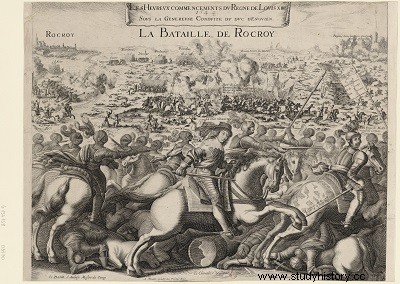
Located in the Ardennes massif, between the Sambre and the Meuse, in the district of Mézières, Rocroi is only a simple farm or a village until the day when François I decides to fortify it. In 1555, the small square was besieged by the Imperials and later, during the Wars of Religion, Catholics and Protestants disputed its possession. But it was the battle fought there by the French and the Spaniards on May 19, 1643 that made it famous.
The hope of disarray in the government of France and in the command of its armies following the disappearance of Richelieu and that, which we know to be imminent, of Louis XIII, decides the governor of the Spanish Netherlands, Don Francisco Melo de Braganza, to invade France. His plan is to take the place of Rocroi, to turn the towns of Oise, Guise, La Capelle and La Fère to the east, and to march on Paris by the valleys of the Aisne and the Marne. The French army, placed under the command of the Duke of Enghien (the future Grand Condé*) then moved quickly towards Rocroi where the. Spaniards hastily take their order of battle. Enghien commands the French right; with Gassion*, mestre de camp general of the cavalry, he furiously attacked the opposing cavalry and broke it. Then, instead of pursuing it, he passes behind the center of the enemy, attacks the Spanish left, which was victorious, from behind, and throws it into disorder. But, in the center, “remained this formidable infantry of the army of Spain e, the famous tercios, commanded by the count of Fontaines. Started by the cannon, pressed by the men on foot, charged and reloaded by the cavalry of the Duke of Enghien, it lost almost all its officers, most of its men, and capitulated. This great victory had demonstrated the great military talents of the Duc d'Enghien.
Ten years later, Condé seized Rocroi again, but this time on behalf of the Spaniards, at the whose service he had passed, and the position did not return to France until the Treaty of the Pyrenees* (November 1659). Its fortifications were then altered by Vauban*. They are still intact today. Besieged in 1870 by the Prussians, the place surrendered after a few hours of bombardment.
Marked by the capture of the Tuileries and the massacre of its Swiss garrison , the day of August 10 essentially appears as the last phase of the monarchical revolution. Pressed by the people of Paris, the Legislative, in the face of a riot, which it fears it will not be able to curb, decides to sus
